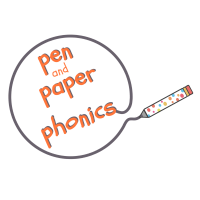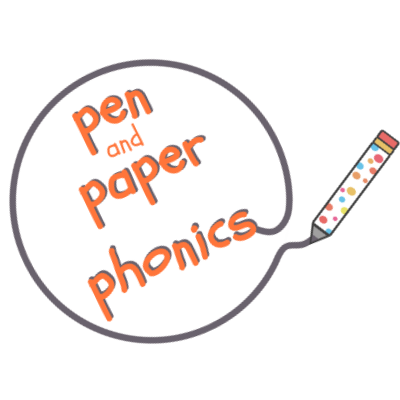
Welcome! You’ve arrived at the one stop shop all about phonics activities (basically, what this site is all about!)
This page covers quite a lot of info – so feel free to read it as it comes, or jump straight to the bit you are interested in.
Phonics Activities:
- What are they?
- Who are they for?
- How do they help with reading?
- How can you use them?
- Why Pen and Paper?
What Are Phonics Activities?

Phonics activities are educational activities, designed to teach and reinforce phonics skills.
Phonics is key to a child’s reading and writing journey. It is all about the letters and sounds in the English language.
Related Content: Click here for a more detailed look at what phonics is.
This site aims to provide ways to teach and reinforce key phonics skills that will help children to learn to read and write.
And children like fun, interactive and engaging games. So, this site provides quick, engaging activities to teach phonics.
Who Are Phonics Activities For?

Basically, phonics activities are for all children who are learning to read. This includes getting ready to learn to read (e.g. birth to 3, 4, or 5 years old), starting to read (around 4, 5 or 6 years old) and continuing to reading fluency (late elementary, or primary school).
You will notice the age ranges above are quite wide. That is because all children learn at their own pace.
Some children master reading very quickly, and others take a bit longer. Indeed, many older students will need reminding of phonics rules, even after they have mastered reading.
The activities on this site are for toddlers, preschoolers, kindergarteners, 1st Graders and 2nd Graders, and students up until about 5th grade, or 11 years old. Each activity is tagged for its ideal age range, although like we said, all children learn at different rates.
If you spend time on this site, or even just google ‘phonics’, you will see that phonics covers a great deal of information.
It encompasses distinguishing different sounds in the environment, learning the letter sounds of the alphabet and understanding the spelling rules that govern the English language.
Anything that helps children in the reading journey to the end goal of reading fluency, is valuable. And phonics activities are a crucial part of this help.
How Do Phonics Activities Help With Reading?
You might have this quote before:
Tell me and I forget; show me and I remember; involve me and I understand.
Chinese Proverb
Variations of this idea are many and are attributed to different people. But they all make a similar point – we learn best when we are actively involved in the learning process.
Now, we all learn in different ways: some people are more visual learners, others remember what they hear, and others prefer to learn through movement. But whichever way we learn, we do it best when we are engaged.
Activities using phonics help children and students to become actively involved in their learning.
This is because activities use visual, auditory and kinesthetic (movement) teaching strategies, allowing children to more easily remember what they are learning.
Phonics activities are an interactive teaching tool. They teach and practice knowledge and skills in a fun and engaging way, so that they become natural for use when reading independently.
The phonics activities on this site, like all good phonics activities, help to introduce, consolidate and teach reading in two main ways:
Multisensory
First of all, they are multisensory. They involve listening, seeing, speaking and moving. Sometimes an activity will involve all four. At other times, it will utilize one over the others.
Adaptable and Differentiated
Secondly, they are easily adaptable and differentiated. They can be adapted by changing the content, by focusing more heavily on a particular learning style, or by increasing the level of difficulty.
For example, the racetrack activity below can easily be changed to teach various different letter sounds and words:


Because they are multi sensory and easily adaptable, they provide engaging, interactive and tangible ways of learning.
How Can You Use Phonics Activities?
Phonics activities can teach a discreet concept. For example, teaching that the letter ‘s’ makes an /s/ sound.
Or, they can be used to reinforce a concept and provide reading practice. For example, a child may know the ‘magic e’ rule. However, they will need practice in reading words that use this rule. Then, when they come across it in a text, they will be more confident in reading it.
The activities on this site can be used to teach a discreet concept, or to provide reading practice for rules already learned.

There is a range of different types of activities. For example, some activities are outdoor, active games, and others are quieter, table top games. Some activities are printable and ready to go, others you can prepare with your child or student. And there are activities that only require a pen and paper, and others that use a physical resource like letter magnets.
Content of Phonics Activities
If you have a good idea of what you want your child to learn or remember through the activity, then lots of good learning will be had.
It is important that the overall teaching of phonics follows a progression. For example, students should in general know what sounds the common letters make before they start to read words and sentences.
Often phonics curricular use an order such as ‘satpin’. This is a common starting place as they are common letters that make a lot of simple three letter words. Other times, people start with the letters in a child’s name, as these will become very familiar.
Whichever progression or curriculum you follow, there are lots of phonics activities that help teach and practice different phonics aspects.
The great thing about activities is that they are flexible and adaptable. You can use them to teach a concept that your child or student is finding very difficult. Or, you can use them as part of a daily progression of phonics teaching.
Using Phonics Activities at Home

Phonics activities can be done at home, by parents to support their child’s learning alongside their school, or when homeschooling children.
The activities on this site are designed to give you background information on what the activity will teach, and how to teach it.
You don’t need to have lots of phonics knowledge to deliver them. You also don’t have to be an amazing, all singing, all dancing instructor. Just be yourself – kids love to be active and they don’t mind if you are just their audience!
Using Phonics Activities in the Classroom

In addition, these games are ideal for use in a classroom setting, for example, in a small group, or during individual instruction.
What Are Pen and Paper Phonics Activities?

We’ve been talking a lot about the phonics activities on this site. And you might be wondering, ‘Why Pen and Paper phonics?’
The main reason is that there doesn’t always need to be loads of resources available to teach phonics.
A pen and paper are always to hand, and can be used to make quick and simple games to help children learn.
But basically, anything capable of making a mark will, and does, work – and is included in these activities. Chalk, sand, stamps, tablets, sticks or markers are all effective.
Pen and Paper Phonics Activity Format
Each blog post provides an activity linked to an area of phonics learning. Each post follows a similar format:

After a brief introduction, there is an outline of the basic idea for the activity and an example of how to use it. Then, you can choose either to do the activity as it is, or to adapt it to suit the learning that your child or student is currently working on.

Each activity also gives advice on some things to watch out for. Because, with children, even the best of games can go off track rapidly. So I’ve highlighted some of the things that could go wrong. Forewarned is forearmed!

All the activities are easily adaptable.
Often this might mean changing the content (what you will teach), so that it better fits what your child is learning. For example, using more challenging words.
Sometimes, it will mean changing the method (how you will teach it). For example, taking it outside, or swapping roles so that your child becomes the ‘teacher’.
Resources

Each activity plan tells you what you will need, and how to make the activity.
In addition, each post contains downloadable pdf printable resources. These are word lists, or resources to help make the activity.
I know how difficult it is to quickly think of words that conform to a certain pattern – I have been there!

Nearly There!
If you’ve got this far – kudos! Well done!
I really appreciate you sticking with it. Hopefully, you will have gained an overview on the importance and usefulness of using games and activities when teaching phonics.
To Wrap Up
- Phonics Activities teach phonics in an interactive and fun way.
- They help to teach and reinforce phonics learning and so are a valuable tool in the ‘learning to read’ process.
So there we have it. Pen and Paper Phonics. Quick, Fun, Phonics Activities.
Have a look around the site, see which activities work for you and your child. In addition to the activities on this site, there are so many amazing places to find phonics activities. Click through to see my pinterest boards, packed full of great ideas.
I’d love to hear how you get on and if you have any questions. And, if you would like to see an activity for a particular phonics concept, please let me know. You can leave me a comment, or email me at hannah@penandpaperphonics.com.

